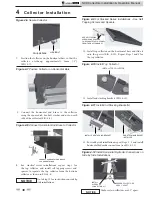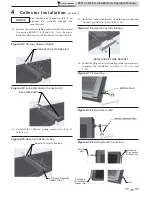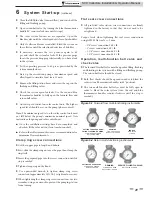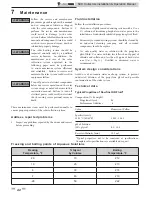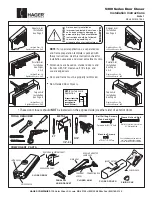
40
Start-up
6
System Start-up
SCH Collectors Installation & Operation Manual
Check/control water chemistry
Do not use petroleum-based cleaning
or sealing compounds in the system.
Damage to elastomer seals and gaskets
in the system could occur, resulting in
substantial property damage.
CAUTION
Test/replace freeze protection fluid
1. For systems using freeze protection fluids, follow fluid
manufacturer’s instructions.
2. Freeze protection fluid must be replaced periodically due
to degradation of inhibitors over time. Follow all fluid
manufacturer’s instructions
.
Freeze protection
1. Determine freeze protection fluid quantity using
system water content, following fluid manufacturer’s
instructions. Remember to include expansion tank
water content.
2. When using freeze protection fluid with automatic fill,
install a water meter to monitor water makeup. Freeze
protection fluid may leak before the water begins to
leak, causing concentration to drop, reducing the freeze
protection level.
3. The freeze protection set points may be lowered when
freeze protection fluid is used (see the Lochinvar Solar
Differential Control Manual).
Glycol
Aqueous solutions of Dowfrost HD fluid are designed to
provide freeze/burst and corrosion protection, as well as
efficient heat transfer, in water-based, closed-loop heating
and air-conditioning systems.
Dowfrost HD fluid has an operating temperature range of
-50°F to 325°F; with fluid freeze protection to below -60°F
and system burst protection to below -100°F. The fluid
contains corrosion inhibitors that are specially formulated
for HVAC systems to keep pipes free of corrosion without
fouling.
Thermal protection
In heated water systems, a warning instruction must be
provided by the operator near the expansion tank, if persons
are endangered by excessive surface temperatures.
WARNING
The expansion tank may be hot, ensure
scalding does not occur.
WARNING
Failure to heed these instructions, especially
the safety instructions, can result in the
destruction of and defects on the expansion
tank, endanger persons, and impair the
operation.
Final checks before starting the system
Read the Lochinvar/TiSun Differential Control Installation
and Operation Manual to familiarize yourself with
differential control operation. Read this manual and follow
the proper steps to start system.
Verify the collector and system are full of water and all
system components are correctly set for operation.
Verify electrical connections are correct and securely
attached.
WARNING
A properly sized expansion tank must
be used to avoid damage to the Solar
Thermal System.
WARNING
All piping should be properly insulated to
avoid freezing and burn potential.
Filling, flushing and bleeding
■
There is one fill valve with hose connection for filling,
flushing and draining the solar system on both the safety
group and sensor measurement section.
■
Connect the pressure hose (forward flow) to the safety
group’s filling connection under the pressure gauge and
open fill/flush valve.
■
Connect the flushing hose (return) to the flushing
connection on the sensor measuring section and open
fill/flush valve.
■
Refer to “Operation, multi-function ball valve and check
valve” on page 38.
■
Open the supply ball valve (by turning the red
thermometer handle counter-clockwise until it stops).
■
Close return ball valve (by turning the blue thermometer
handle clockwise, until it stops).
■
If necessary, the supply and return check valve can be
opened by moving the thermometer handles to the 45°
position.
■
Put sufficient solar liquid in the tank of a filling and
flushing pump (not supplied). The mixing ratio should be
adapted to local conditions in terms of freeze protection.
■
Fill the solar system via the filling and flushing pump and
then flush the solar circuit for at least 15 min. to purge all
of the air out of the circuit.
■
Close the fill/flush valve (return) with the filling and
flushing pump running and increase the system pressure
to 60 psi. The system pressure can be read at the pressure
gauge.
WARNING
Thermal expansion tanks should be sized
to account for 1.5 times the solar system
circuit volume.





